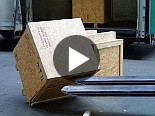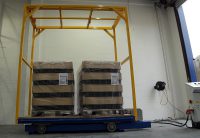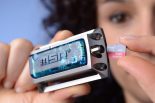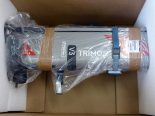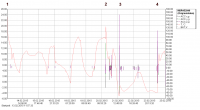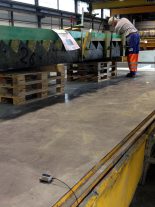Data can be retrieved wirelessly from anywhere – alarm messages and secure documentation
Pharmaceuticals are sensitive products; their quality can be impaired, for instance as a result of incorrect storage temperatures or exposure to humidity. Therefore, in a professional pharmaceutical distribution chain, these environmental parameters must be monitored accurately and documented in a clear manner. Mini data loggers the size of a thumb provide indispensable support for this.
Correct storage of pharmaceuticals of all kinds is essential and guarantees that these products continue to be effective and retain the proper potency until the expiry date specified by the manufacturer. Strict regulations that are incorporated into the law of the Arzneimittel-Bewilligungsverordnung (AMBV – Ordinance on the Authorisation of Pharmaceuticals) issued by the Swiss Federal Council form the basis for the correct storage of pharmaceuticals and sample pharmaceuticals; they are known as GDP (Good Distribution Practice). Therefore, compliance with the GDP regulations is essential and indeed existential for pharmaceutical companies, as inaccuracies or even gross violations thereof may result in significant damage to the company’s image as well as financial loss.
Temperature and humidity: the quality parameters
 As an international pharmaceutical manufacturer who is active in various fields of medicine, e.g. pain management and cancer treatment, Italy-based company sigma-tau Pharma AG is especially bound to the effective country-specific regulations. For instance, within the scope of its quality assurance activities, this company’s subsidiary in Switzerland sought a suitable technical concept to help optimally monitor the critical environmental parameters, “temperature” and “relative humidity”, in the distribution chain for pharmaceutical samples supplied to chemists and doctors, and to document them according to modern aspects. In practice, the sample packages to be distributed are stored in different locations, generally at room temperature – usually between 15 and 25 degrees Celsius. However, on the one hand the temperature in the storage location must not fall below or rise above this temperature range, whilst on the other hand the humidity must remain at a reasonable level.
As an international pharmaceutical manufacturer who is active in various fields of medicine, e.g. pain management and cancer treatment, Italy-based company sigma-tau Pharma AG is especially bound to the effective country-specific regulations. For instance, within the scope of its quality assurance activities, this company’s subsidiary in Switzerland sought a suitable technical concept to help optimally monitor the critical environmental parameters, “temperature” and “relative humidity”, in the distribution chain for pharmaceutical samples supplied to chemists and doctors, and to document them according to modern aspects. In practice, the sample packages to be distributed are stored in different locations, generally at room temperature – usually between 15 and 25 degrees Celsius. However, on the one hand the temperature in the storage location must not fall below or rise above this temperature range, whilst on the other hand the humidity must remain at a reasonable level.
Measurement technology stores data in miniature format
Whilst in the past, electronic recording systems were used to monitor the ambient temperature and humidity, these are no longer compliant with the current requirements of sigma-tau, in particular as the employees working within the distribution chain are now equipped with iPad computers. For this reason, both modern, wireless transmission technology and practice-oriented recording software are required.
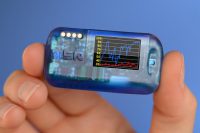 When looking for new, compact data recording devices equipped with modern sensor, measured data recording and transmission technology, sigma-tau came across the MSR145WD wireless data loggers of Seuzach-based MSR Electronics GmbH. These small data recording devices record the crucial, calibrated parameters “temperature” and “relative humidity” in freely adjustable scanning intervals, ranging from seconds to hours, and store this measured data in an internal semiconductor memory.
When looking for new, compact data recording devices equipped with modern sensor, measured data recording and transmission technology, sigma-tau came across the MSR145WD wireless data loggers of Seuzach-based MSR Electronics GmbH. These small data recording devices record the crucial, calibrated parameters “temperature” and “relative humidity” in freely adjustable scanning intervals, ranging from seconds to hours, and store this measured data in an internal semiconductor memory. 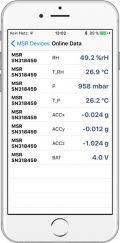 The recording capacity of this memory is sufficient for monitoring taking place over several months (1 million recorded values). Furthermore, it is possible to record the air pressure, light intensity and acceleration/location, which is not required in the case of the sigma-tau Company. The mini logger, which is barely the size of a thumb, is powered by an internal battery that is charged automatically when configuring the logger via the USB connection and that is available with two different capacities, facilitating even long-term measurements over a number of months.
The recording capacity of this memory is sufficient for monitoring taking place over several months (1 million recorded values). Furthermore, it is possible to record the air pressure, light intensity and acceleration/location, which is not required in the case of the sigma-tau Company. The mini logger, which is barely the size of a thumb, is powered by an internal battery that is charged automatically when configuring the logger via the USB connection and that is available with two different capacities, facilitating even long-term measurements over a number of months.
The temperature and humidity values can be read from the very bright display that has been integrated into the mini logger; however, the engineers of MSR have also integrated wireless electronic features into the small data recording devices, e.g. the “Bluetooth Low Energy” (BLE) wireless short-range radio data transmission. By now, this very low-energy wireless standard has also been integrated into smartphones and tablets of all kinds, therefore they are able to communicate with the small data logger via BLE and read out and display the measured values: Within a radius of approx. 10 m – the distance bridged by BLE radio technology – the temperature and humidity values of the storage location can be checked directly via a tablet or smartphone.
The cloud: monitoring data from anywhere
 Yet, Wendelin Egli, CEO of MSR Electronics GmbH, reports even more possibilities of remote reading: “In addition to viewing the measured values on the logger display or at short range on a Bluetooth-enabled mobile device, the temperature and humidity data can also be monitored completely irrespective of the location. By using a BLE-enabled laptop in the vicinity of the logger, a special BLE receiver box, or a smartphone or tablet in the vicinity of the logger, all data can be stored in a protected cloud specifically created for this purpose by MSR via the Internet connection of the respective device.
Yet, Wendelin Egli, CEO of MSR Electronics GmbH, reports even more possibilities of remote reading: “In addition to viewing the measured values on the logger display or at short range on a Bluetooth-enabled mobile device, the temperature and humidity data can also be monitored completely irrespective of the location. By using a BLE-enabled laptop in the vicinity of the logger, a special BLE receiver box, or a smartphone or tablet in the vicinity of the logger, all data can be stored in a protected cloud specifically created for this purpose by MSR via the Internet connection of the respective device. 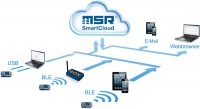 As soon as the data is available in the cloud, the person responsible for quality at sigma-tau will be able to obtain an overview of the storage conditions in every single warehouse. The applications arising from this “MSR SmartCloud” range even further: Limit values previously defined while configuring the logger on the PC, for instance for the temperature, can also trigger alarm messages via the cloud. If required, the measured values from several MSR145WD data loggers can be read out and even shared with a team.
As soon as the data is available in the cloud, the person responsible for quality at sigma-tau will be able to obtain an overview of the storage conditions in every single warehouse. The applications arising from this “MSR SmartCloud” range even further: Limit values previously defined while configuring the logger on the PC, for instance for the temperature, can also trigger alarm messages via the cloud. If required, the measured values from several MSR145WD data loggers can be read out and even shared with a team.
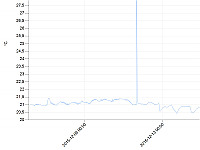 Finally, the small data loggers permanently store all recorded measured values and in the specific case of medicine monitoring at sigma-tau, where ten of these “miniature measurement technology laboratories” are currently being used, they are read out on a monthly basis for documentation purposes and presented clearly by means of a specific software in a “monthly chart”. This way, the storage conditions are documented in a clear, unambiguous manner that is comprehensible by all persons responsible; furthermore, they are archived permanently. Of course, in case of doubt, potentially unsafe storage locations can also be identified this way – possibly through a kind of “test run” without real pharmaceuticals. In any case, continuous monitoring with the aid of these small high-tech data loggers safeguards the quality of the medicines permanently and ensures that it is documented it in a manner that will stand up in court.
Finally, the small data loggers permanently store all recorded measured values and in the specific case of medicine monitoring at sigma-tau, where ten of these “miniature measurement technology laboratories” are currently being used, they are read out on a monthly basis for documentation purposes and presented clearly by means of a specific software in a “monthly chart”. This way, the storage conditions are documented in a clear, unambiguous manner that is comprehensible by all persons responsible; furthermore, they are archived permanently. Of course, in case of doubt, potentially unsafe storage locations can also be identified this way – possibly through a kind of “test run” without real pharmaceuticals. In any case, continuous monitoring with the aid of these small high-tech data loggers safeguards the quality of the medicines permanently and ensures that it is documented it in a manner that will stand up in court.
Can we also help you with your measuring tasks? We would be pleased to advise you!
You may also be interested in these articles:
- MSR145WD Wireless Data Logger with BLE, Display and MSR SmartCloud
- MSR Data Loggers: Quality monitoring of shocks and vibration immissions during road transport of highly sensitive medical devices
- Fall detection by smart phone in older adults – with Data Logger MSR145
- MSR Data Logger used for space medicine: Cell culture experiments in microgravity on board the military fighter jet aircraft F-5E “Tiger” of the Swiss Air Force
- MSR165 in use for medical technology: Mini Data Loggers assist with workpiece optimisation
- The fast way to the right Data Logger
 Deutsch
Deutsch





